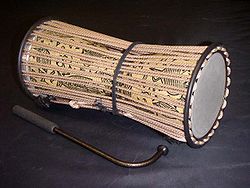Traditional music in The Gambia is very similar culturally
to that of its neighbor, Senegal.
Certainly the most prominent part of Gambian music is the percussion
traditions of the Wolof and Serer people.
The sabar is not only a specific type of drum, but it has
also lent its name to the style of playing using this drum. In saber music, the ensemble includes
the saber drum as a rhythmic drum, but it also includes the nder drum that is
used as the lead drum, and the tama drum (also called a talking drum – it has
different pitches and timbres when you squeeze the sides of the drum, almost
sounding like it’s talking).
In both njuup and saber music, styles commonly performed by
the Serer tribes, music is divided into smaller motifs, each with its own
meaning. Tribes used to use this
style of drumming as a means of communication between themselves and other
tribes; these rhythmic motifs could be heard for up to 15 km (about 9.3 mi)
away. That sounds incredible, but
I suppose perhaps the lack of noise pollution and their location near the river
help the sound travel.
The Mali Empire influenced Gambian music with the role of griots
(sometimes called jelis). Griots were a type of historian-musician-praise
singer-storyteller-poet. They’re
sometimes likened to what a bard was in British and Celtic history.
Mbalax is a type of dance music that mixes Western style
music with the sabar and other traditional musical styles of the Wolof and
Serer peoples.
Gambian musicians started venturing into modern musical
styles during the 1960s and 1970s. Among the first notable musicians include Guelewar
(I can hear influences of jazz, reggae, American rock, African styles, and
maybe even early ska, relies heavily on African drums and percussion.) and Laba
Sosseh. I listed to two albums of Laba Sosseh and absolutely love it. It’s
heavily influenced by jazz and reggae, and Latin music. I listen to his music
while I work.
Other more contemporary musicians that I listened to are Ifang
Bondi and Jaliba Kuyateh. Both of
these musicians tend to borrow from other African styles. Ifang Bondi means “be yourself” in
Mandrika, one of the languages spoken in The Gambia. They were known for incorporating
traditional instruments, rhythms, and traditional styles into their music. Jaliba
Kuyateh is extremely gifted at the kora, an instrument made of wood
(originally, it was made from a calabash or goard), stretched with cow skin,
and has 21 nylon strings. Eleven strings are played with the left hand and the
right hand plays the other ten.
His use of the kora in his music has rendered him the nickname “King of
Kora.” Foday Musa Suso is another kora player who performed years before
Kuyateh. I love this instrument; it’s so beautiful. It almost has a harp-like
or like a Russian balalaika even. I could listen to it all day. I highly
recommend the album The Dreamtime for
anyone interested in the kora. (It’s on Spotify.)
And The Gambia also has a sizable hip-hop scene, mostly
influenced by the styles from the US, UK, and the Caribbean. And since I’m
extremely interested in hip-hop music from other countries, I had to make sure
I have some in my playlist. Unfortunately, I could only find one musician
available on Spotify, and that honor goes to Singateh. There is a deep reggae
influence in his music, and he also uses other featured singers in his music. I
also noticed that his music isn’t strictly rapping; he also has many songs
where he sings as well. I really like it. It’s pretty cool. Like me.

No comments:
Post a Comment